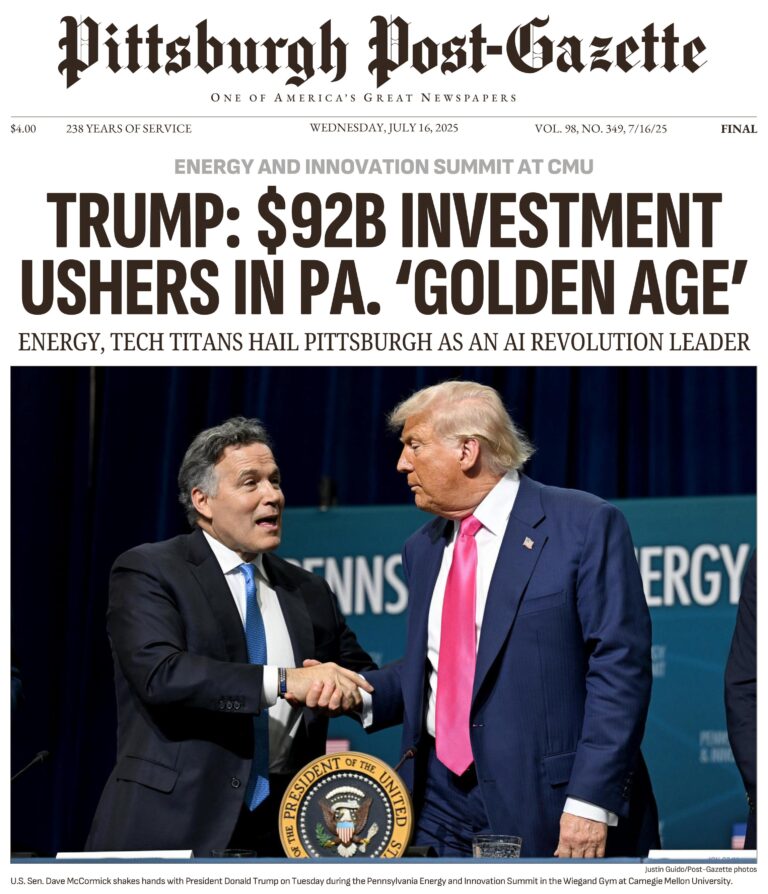Trump and Senator Dave McCormick Announce $70 Billion Energy Investment to Transform Pennsylvania’s Economy
Former President Donald Trump and Senator Dave McCormick are collaborating on a landmark $70 billion initiative designed to revolutionize Pennsylvania’s energy sector. This ambitious plan aims to stimulate economic growth, enhance infrastructure, and create thousands of jobs by leveraging both traditional and renewable energy sources. By combining investments in natural gas, coal, and cutting-edge clean energy technologies, the project seeks to position Pennsylvania as a pivotal hub in the evolving national energy framework.
The investment strategy encompasses several critical areas, including:
- Construction and modernization of pipelines and refining facilities
- Advancement of carbon capture and storage technologies
- Establishment of innovation centers focused on clean energy solutions
- Comprehensive workforce development programs to equip residents with skills for emerging energy careers
| Investment Focus | Estimated Job Creation | Projected Completion |
|---|---|---|
| Pipeline Infrastructure | 8,000 jobs | 3 years |
| Renewable Energy Research | 5,500 jobs | 5 years |
| Refinery Modernization | 6,200 jobs | 4 years |
| Skills Training Programs | 4,000 jobs | Ongoing |
Comprehensive Overview of the $70 Billion Energy Investment and Its Economic Significance
The $70 billion funding package is designed to invigorate Pennsylvania’s economy by targeting infrastructure enhancement, technological innovation, and workforce readiness. This multifaceted approach includes substantial allocations for renewable energy projects such as solar and wind farms, upgrades to natural gas pipelines, and support for research in clean energy technologies aimed at reducing emissions and improving energy storage capabilities.
- Expansion of solar and wind energy installations: Increasing renewable energy capacity in both urban and rural settings.
- Pipeline modernization: Enhancing the safety and efficiency of natural gas transport systems.
- Workforce education: Preparing a skilled labor force to meet the demands of a growing energy sector.
- Research and development: Investing in innovative technologies to drive sustainable energy solutions.
Economic projections indicate substantial benefits, including increased employment, higher tax revenues, and greater investment inflows. The table below summarizes the expected impact across key sectors:
| Sector | Investment ($B) | Jobs Created (Thousands) | Output Growth (%) |
|---|---|---|---|
| Renewable Energy | 25 | 15 | 12 |
| Natural Gas | 20 | 10 | 8 |
| Infrastructure | 15 | 8 | 6 |
| Research & Training | 10 | 5 | 4 |
How Pennsylvania’s Communities Will Benefit from the Energy Investment
The $70 billion energy investment championed by Trump and Senator McCormick is expected to serve as a catalyst for revitalizing Pennsylvania’s local economies. By injecting capital into infrastructure projects, renewable energy developments, and manufacturing, the plan aims to generate tens of thousands of jobs, particularly in regions historically reliant on heavy industry.
Key advantages for local populations include:
- Creation of over 25,000 direct and indirect employment opportunities within five years
- Infrastructure improvements that enhance connectivity and access to modern energy resources in rural communities
- Boosted local tax revenues to support education, healthcare, and public services
- Expanded vocational training initiatives to prepare residents for careers in emerging energy sectors
| Sector | Projected Job Growth | Community Benefits |
|---|---|---|
| Renewable Energy | 12,500 jobs | Improved air quality and public health |
| Manufacturing & Technology | 8,000 jobs | Economic diversification and wage growth |
| Fossil Fuel Modernization | 5,000 jobs | Sustained energy output and job retention |
Strategic Policy Measures to Maximize the Energy Investment’s Impact
Transparent governance will be essential to ensure the $70 billion investment delivers its full potential. Policymakers should establish rigorous monitoring and reporting systems to oversee fund distribution and project milestones. This approach will foster accountability, build public confidence, and allow for timely course corrections.
Engaging a broad spectrum of stakeholders—including local residents, environmental advocates, and industry experts—will be critical to aligning the initiative with community needs and sustainability goals. Furthermore, incentivizing innovation in clean energy technologies alongside comprehensive workforce training will prepare Pennsylvania’s labor force for the future energy economy.
To reduce reliance on any single energy source and enhance resilience, investments should be diversified across solar, wind, and energy storage technologies. The following table outlines priority areas for policymakers:
| Focus Area | Recommended Actions |
|---|---|
| Transparency & Accountability | Implement regular audits and public progress reports |
| Community Involvement | Facilitate inclusive decision-making forums |
| Innovation & R&D | Increase funding for sustainable energy technologies |
| Workforce Development | Expand vocational training and reskilling programs |
| Energy Portfolio Diversification | Balance investments across renewables and traditional sources |
Final Thoughts
As former President Donald Trump and Senator Dave McCormick prepare to reveal their $70 billion energy investment plan, Pennsylvania stands on the cusp of a transformative era. This initiative promises to reshape the state’s energy infrastructure, stimulate economic growth, and generate substantial employment opportunities. The coming months will be critical in observing how these investments influence Pennsylvania’s position within the national energy sector and contribute to the prosperity of its communities. Stay tuned to 90.5 WESA for ongoing coverage and updates.








